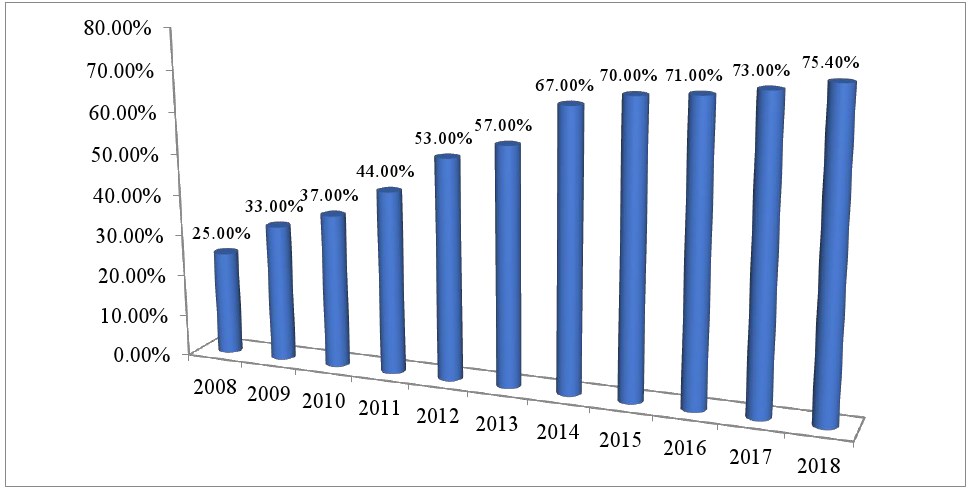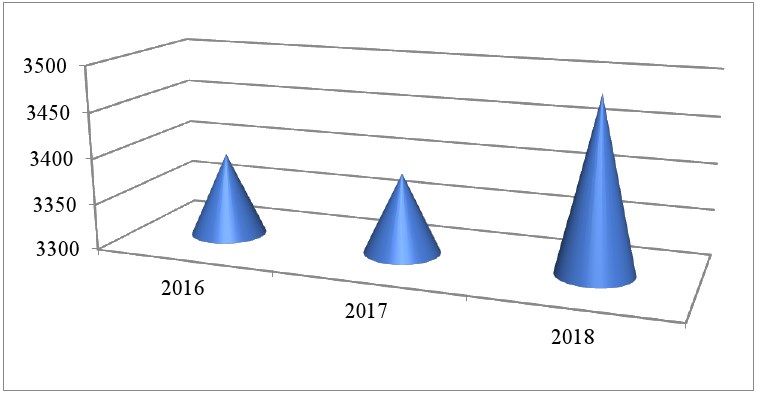Олег Шахов, Маргарита Шахова, Юлия Сизова, Екатерина Русакова, Михаил Дудин Digital Technologies as a Driver of Intellectual Stratification of Human Resources: Socio-Economic Inequality
International Journal of Recent Technology and Engineering (IJRTE) ISSN: 2277–3878 (Online), Volume-8 Issue-2, July 2019
Mihail Nikolaevich Dudin, Oleg Fedorovich Shakhov, Margarita Sergeevna Shakhova, Ekaterina Petrovna Rusakova, Yulia Sergeevna Sizova
Revised Manuscript Received on 30 July 2019. * Correspondence Author Mihail Nikolaevich Dudin*, Market Economy Institute of RAS (MEI RAS), Moscow, Russia; Russian Presidential Academy of National Economy and Public Administration (RANEPA), Moscow, Russia. Oleg Fedorovich Shakhov, Russian Presidential Academy of National Economy and Public Administration (RANEPA), Moscow, Russia. Margarita Sergeevna Shakhova, Lomonosov Moscow State University (MSU), Moscow, Russia. Ekaterina Petrovna Rusakova, Peoples' Friendship University of Russia (RUDN University), Moscow, Russia. Yulia Sergeevna Sizova, Plekhanov Russian University of Economics, Moscow, Russia. © The Authors. Published by Blue Eyes Intelligence Engineering and Sciences Publication (BEIESP). This is an open access article under the CC-BY-NC-ND license http://creativecommons.org/licenses/by-nc-nd/4.0/Abstract: The goal of the research is to cover the problem of digital inequality considering its negative consequences for society, to conduct a geospatial analysis of the distribution of informational resources among the countries around the world and to determine the main trends of their technological development. Methods. This article uses the following methods: empirical, systematic, analytical, economic and other methods for the research of digital technologies as a driver of intellectual stratification of human resources. Results. The author has studied digital technologies as a driver of intellectual stratification of human resources. The article analyzes the phenomenon of digital inequality as one of the key problems of microsystem development, as well as the geospatial characteristics of this problem. Index Terms: digital inequality, digital technologies, geospatial features, intellectual stratification, microsystem.
I. INTRODUCTION
In the modern era of the emergence of information society and globalization, there is an urgent need to access information resources both at the national and international levels. The features of modern times include the important role of information and information technology (IT) in the socio-economic relations of humanity, the growing share of information products and services in GDP of the world’s economies and an increase in the number of people employed in the sphere of information and communications technology (ICT). This explains the relevance of the search for ways to eliminate digital inequality as a phenomenon that poses a challenge for society at this stage of its development. In view of the above, the goal of the research is to cover the problem of digital inequality considering its negative consequences for society, to conduct a geospatial analysis of the distribution of information resources among countries and to determine the main trends of their technological development.II. LITERATURE REVIEW
The study of digital inequality is carried out by scientists all over the world: this issue is addressed not by just one organization. Well-known researchers, such as A.N. Semyonova, V.A. Stupkina [1], M. Rozin [2], T. Aleshkina, Yu. Yarosh [3], N. Albrekht [4], A. Balashova, R. Rozhkov [5], A. Belaichuk [6], D. Bulin [7] and many others, dedicate their work to this issue. Each of them considers IT as a driving force of the present, but at the same time, each one sees in this force a threat of increasing gap between technologically rich and technologically poor countries. Thus, according to the majority of researchers, the modern world is divided not ideologically but technologically. The higher the technological capacities of some countries, the more other countries lag behind them. To address the issue of digital inequality, a number of indicators were developed for an in-depth study of the problem. Such indicators differ depending on the researcher’s individual approach.III. PROPOSED METHODOLOGY
A. Block Diagram The phenomenon of the digital gap receives considerable attention from the world organizations, unions, integration associations (International Telecommunication Union, European Union and United Nations institutes). The basis of their actions on overcoming digital inequality is formed by the development of statistical reports, planning of programs for the elimination of technological backwardness of particular countries and regions and formulation of a number of proposals and recommendations concerning this problem. The experience in developing digital inequality calculation indexes is fairly common. Fig. 1 illustrates Internet access in Russia in 2008–2018. Fig. 1. Internet access in Russia in 2008-2018
Fig. 1. Internet access in Russia in 2008-2018
B. Algorithm This article uses the following methods: empirical, systematic, analytical, economic and other methods for the research of digital technologies as a driver of intellectual stratification of human resources.
IV. RESULT ANALYSIS
According to the indicators of development, in the modern global space, digital technologies represent a dynamic sphere. For instance, today, the number of mobile connections notably exceeds the number of people. Moreover, the number of people who can use a mobile phone exceeds the number of those who can satisfy their basic needs. In addition, the volume and direction of information flow in countries, their unions and continents are constantly growing, as a result of which the volume of such information in 2016–2018 accounted for more than one-third of the global GDP. These trends are especially impressive considering a certain slowdown in the growth of international trade in goods and services and the international movement of capital. These circumstances affect the continuation of complications in the interaction of public institutes based on modern digital technologies both at the national and international levels. As a result, massive data flows become the basis for the formation and development of the digital economy, which is able to fully and effectively ensure production, processing, storage, transfer, use and protection of information. In particular, today, as argued by some researchers, in order to obtain an economic effect, it is important not only to have a certain resource but to have comprehensive data about this resource and the possibility to use them in the course of planning and decision-making [1]. If each ICT segment of the world market is considered separately, it can be noted that the growth has occurred in the following categories: data centers, software for companies and IT services (Table I).Table I. World expenditure in the ICT sector
 Source: [8].
Source: [8].
Fig. 2 presents the dynamics of world expenditure in the ICT sector in 2016–2018.
 Fig. 1. Dynamics of world expenditure in the ICT sector in 2016–2018.
Fig. 1. Dynamics of world expenditure in the ICT sector in 2016–2018.
Despite the gradual elimination of borders and the establishment of close relations among countries, there is still an obvious asymmetry, which also manifests itself in the level of access to information resources. Highly developed countries accumulate the majority of information resources. Their investment in the development of science, technical education, information infrastructure, as well as the development of various projects, significantly exceeds the contribution of under-developed countries. Countries with a high level of development are able to spend much more funds on the knowledge sphere. Effective legislation on intellectual property enables them to assert their right for scientific developments. The phenomenon of monopolization in information sphere has such negative consequences for society as stratification of the population on the grounds of intellect, an increase
Последние комментарии
2 часов 45 минут назад
6 часов 59 минут назад
9 часов 18 минут назад
11 часов 7 минут назад
16 часов 53 минут назад
16 часов 58 минут назад